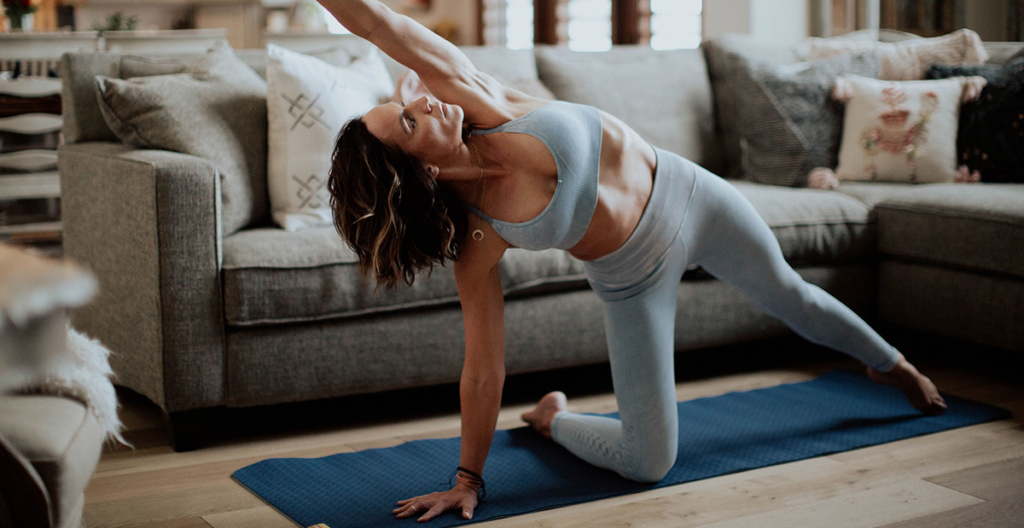
As winter nears, it’s natural to hunker down. This year is unique in that for many of us, doing anything other than hunkering down isn’t an option. COVID has driven many of us indoors. While some yoga studios are open for business, at least in my city, most of them have temporarily or permanently shut their doors. Online yoga classes are the thing, at least for now. So why not set up your own home yoga space?
Before I moved to Mindful Yoga Collective in 2013, I taught yoga classes at Salt Lake City’s First Unitarian Church for 25 years. That gave me a special appreciation for the privilege of teaching in a dedicated yoga space. Still, despite the occasional distractions at the church, the experience taught me that a yoga space does not have to be “perfect” to support a deep yoga practice. Likewise, you don’t have to have “perfect” conditions to set up a supportive yoga space in your home.
Do You Need a Dedicated Home Yoga Space?
You may live in a home that’s big enough that you can dedicate an entire room to practice space. If that’s the case, you can keep your yoga mat unrolled and ready to go 24/7. You might also want to set up a meditation cushion as well. And of course, you can stock your space with bolsters, blocks, straps and blankets too. This, of course, is ideal.
However, most of us don’t have room in our living space to set up a permanent home yoga studio. But that doesn’t mean we can’t practice. When I teach yoga on Zoom, I can see that, with one exception, my students are practicing in rooms that serve a dual purpose—living rooms, guest rooms, bedrooms, TV rooms, etc. I teach in my living room, simply because it has the best light, and it’s big enough that I can position my computer far enough away from my mat that students can see my whole body, even in standing poses.
How to Decide Where to Practice
So how do you choose a home yoga space? Here are a few factors to consider:
- Heavy Lifting: Moving furniture to practice isn’t a deal breaker, but if it’s too complicated, or the furniture is really heavy, you might be less motivated to practice. Consider practicing in a space that requires minimum rearranging.
- Traffic: If you live with others, you might want to choose an out-of-the-way room, maybe a bedroom, guest bedroom or home office. People traipsing through your yoga space can make for good practice—we build equanimity when we learn to practice in imperfect conditions. But it’s helpful to set up in a place where there’s less likelihood of interruptions.
- Space Needs: What kind of yoga do you practice? If you’re used to practicing in a crowded, mat-to-mat yoga studio, you may not need much more space than the length and width of your yoga mat. If you practice Restorative Yoga, you’ll need space to spread out. Allow a bit more space than you think you’ll need, if possible.
- Declutter: Choose an area of your home that’s relatively free of clutter. Or, once you’ve chosen your yoga space, clear out unnecessary clutter. It’s easy to get distracted—and stressed out—when your surroundings are nagging you.
Stock Your Home Yoga Space
Once you’ve chosen your yoga space, decide what yoga props you’d like to have on hand. It’s helpful to keep your props all in one place so that they’re easy to gather. Make them accessible, whether they’re in your yoga space or in a closet in another room.
Here are some suggestions for essential home yoga props:
- Mat: You already know this. A yoga mat is a given. But maybe you’d like to upgrade your mat. Now’s your chance to try a heavier, sturdier mat. If you’re not having to carry your mat to a studio, you can indulge in Hugger Mugger’s stickiest, sturdiest mat, the Para Rubber Yoga Mat.
- Blocks: Whether you’re simply doing a home practice or taking online classes, chances are there will come a time when you need to use one or more blocks. There are lots of choices. Four-inch Foam Blocks and Marbled Foam Blocks are super versatile and very light weight. If you’re not worried about weight, Cork Yoga Blocks, Bamboo Yoga Blocks or Wood Yoga Blocks are great choices.
- Strap: A Yoga Strap is another essential tool for your home yoga space. Like Yoga Blocks, Yoga Straps are not just for the inflexible. They’re helpful in a multitude of poses and practices. For versatility’s sake, I’d recommend a strap of eight or ten feet.
- Blankets: Yoga Blankets can perform many functions. They can stand in for Yoga Bolsters in some poses and can provide support under your hips in seated forward bends. They can even be used as … well … a blanket over your body in Savasana (Relaxation Pose).
- Bolster: Even if you don’t regularly practice Restorative Yoga, you never know when a supported pose might be exactly what your body and mind are hankering for. Sometimes we really just need to relax and decompress. Your home yoga space can be an ideal place to practice Restorative Yoga. At home, there’s no limit on how long you can stay in a pose, and if you fall asleep, it’s not a problem. While Yoga Blankets can substitute for bolsters in certain poses, a real Yoga Bolster is much more versatile, and there are Restorative poses that you can only practice with a bolster.
- Eye Pillow: Remember: there’s no limit on how long you can stay in Savasana when you practice at home. An Eye Pillow can help you relax even more deeply.
There are, of course, other yoga props that you might consider, but the above list is a good start. Please share with us your ideas on putting together a home yoga space!
